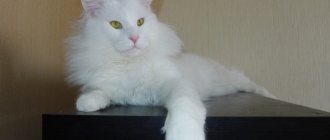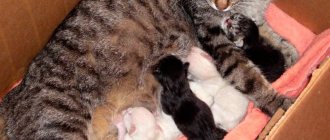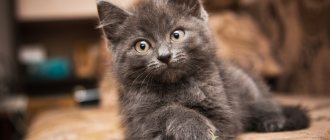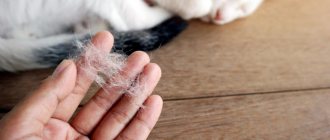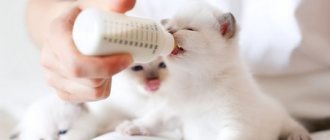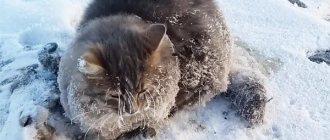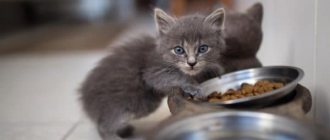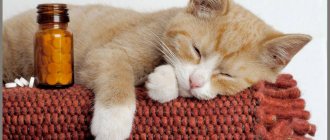Why do eyes change color?
Several factors influence the change process.
The reason is melanin
The amount of dye depends on the breed of animal.
This pigment is formed in the fetus during intrauterine development. Most of it goes into the hair follicles, the organs of vision remain light blue or gray.
Kittens, as representatives of the class of mammals, are born with insufficiently formed organs. Cat cubs are born blind.
After a few days, the eyelids open slightly; the final opening occurs after the first week of life.
Newborn animals have little melanin in the iris. During the process of eye formation, a certain amount of pigment accumulates and a color change occurs.
Genetics
Heredity is responsible for the final shade and the speed of its manifestation.
Genes carry data on the amount of pigment, its color, speed of manifestation, and at what age the process begins.
The amount of melanin in the iris determines its color: with a large amount, the tone of the iris is copper-brown, with a deficiency - yellow, green, blue.
Animal size and weight
If the animal does not have serious diseases, it is permissible to use size and weight measurements to determine age.
Recommendations for the relationship between the age and size of a cat should be taken into account that a particular individual could be born slightly larger or smaller than the average. If this fact occurs, then a deviation of 2–3 centimeters from the average readings is acceptable:
- If the length of the kitten, excluding the tail, is no more than 12 cm, then we can say that it has just been born.
- The length of the body without a tail is 15 cm, so the kitten is about 4 weeks old.
- About 20 cm body length is an indicator of 3 months.
- From the age of two months, boys may be larger in build than girls. With the size of a teenage cat being 23–24 cm, we can assume that the age is about 4 months. A five-month-old girl will measure about 25 cm.
- At the age of six months, the main growth of the animal stops; the length of the body, excluding the tail, is about 26–27 cm. Boys are longer by 2 to 6 cm.
In the system for calculating the weight of a cat, the weight of a newborn is taken as the starting indicator - this is 90–100 g. The deviation for subjective factors is assumed to be 20–30 g. The cat gains weight before reaching the age of two.
At the end of the first week, the approximate weight of the kitten is about 113–115 g. By the end of the second week, it increases to 200 g, by the end of the third - to 280 g. In subsequent weight changes, it increases noticeably faster. By the end of the fourth week, his weight is 370 g, at the end of the fifth - 450 g.
The indications given in the recommendations are conditional and approximate. A healthy kitten, with proper nutrition and care, increases by approximately 100 g every week. Having reached six months, the cat develops more slowly. Noticeable changes in weight will appear once a month. Even with abundant feeding, the animal gains little weight over the course of a week. The parameters of weight, height, eye color and other characteristics are set very conditionally, therefore, to obtain more accurate information, it is necessary to compare data from different age determination methods.
Determining the weight of an active, curious pet is quite possible at home. The kitten's maximum activity occurs at six months. This period lasts up to one and a half years. As time passes, the animal becomes calmer.
When the color changes
This factor depends on heredity.
In outbred cats, pigment appears at the age of 1.5 months. In representatives of the breeds, the process of changing shade begins approximately 30 days after birth and lasts about a year. The final color of the iris can be assessed by 2 years.
All kittens have bright blue eyes at the age of one month. Until this time, they are grayish due to the film that covers the cornea after the eyelids open.
When choosing a kitten, they focus on the color of the iris from the age of 4 months, when its main shade begins to form.
Dental changes
Just as a human child's new teeth grow gradually, a kitten's teeth do not appear at the same time.
Kittens are born without teeth, and from the second week their first milk teeth begin to erupt. At 2–4 weeks, the incisors emerge, at 3–4 weeks, the canines appear, and at 6–8 weeks, the premolars appear. Kittens do not yet have molars, that is, molars. In total, animals have 26 milk teeth, which differ in structure and color from permanent ones.
Starting from 3.5 months, the replacement of baby teeth with permanent teeth occurs. The process starts with the first and second incisors. From the fourth month - premolars; from the fifth – molars. From 5.5 months, the canines on the upper and lower jaws are replaced. From the fifth month, the replacement of rudimentary fangs on both jaws begins. The process lasts up to 7 months. Like human teeth changing, the process is individual and can last up to 9 months. In males it begins earlier than in females.
So, an adult has 30 permanent teeth:
- 12 incisors are divided into sixes of the upper and lower jaws;
- 4 fangs - two on each jaw;
- 10 premolars;
- 4 molars.
Knowing and clearly distinguishing the sequence of appearance and names of teeth will help you recognize the age of a kitten by the appearance or eruption of teeth. An illustration will help you avoid getting confused about the names and locations of teeth.
When determining the age of a kitten, you should pay attention to its behavior. If your pet has ruined the furniture upholstery by chewing it, hunts for shoelaces and chews them at night, this may be a sign of teething
When teething, there is a need to chew toys, bedding, and other objects that interest the animal.
It is indeed possible to determine the age of a baby by the appearance of teeth, but if the animal is an adult, this approach may fail. For a mature individual, the condition of the teeth will indicate age only approximately. An old cat may have both diseased and dilapidated teeth.
By the age of one and a half years, the main lobes of the first incisors of the lower jaw are fully formed. According to average indications, there are data characterizing tooth abrasion, however, due to the specific characteristics and subjective indicators of the life of an adult cat, they may not coincide with the real situation. If the lobes of the first and second incisors on the lower jaw are erased, then the cat is already at least 2–2 years and 5 months old. The lobes of the first incisors on the upper and lower jaws are worn away by the age of 3 years and 5 months. If a cat has worn out the lobes of the first and second incisors of both jaws, then he is at least 4 years and 5 months old. If the lobes are present only on the canines of the upper jaw, then the age of the animal is close to 5 years and 5 months. If the surface of the incisors is oval, the cat is about 10 years old. Loss of the first and second incisors on the upper and lower jaws is typical for 12 years. Loss of all incisors is typical for people aged at least 16 years.
Myths
In blogs of animal lovers you can find many erroneous opinions about what affects eye color and in how many months (years) it changes.
The most common myths:
- All newborn kittens have the same eyes. But in fact, the iris can be gray, blue, light blue depending on the breed and age of the animal.
The shade depends on the coat color - this assumption is true mainly for purebred pets. They are genetically assigned a certain color during long-term breeding work. In outbred cats, the tone can be anything, regardless of coat color.- The influence of nutrition on eye color is a deep misconception. Science knows cases of the effects of certain products on coat color. This applies to color point cats, whose fur darkens when they eat fish. But in general, food does not affect the color of cats or the color of their irises.
In an adult, the eyes do not change throughout life. A sharp change in shade signals the development of diseases: leukemia, ophthalmological pathologies, infections, uveitis.
And in this case there are exceptions:
the Kenyan forest cat (sokoke) has an iris that changes depending on his mood;- Albino cats completely lack melanin, their eyes are red, in rare cases pale blue;
- Color Pointers do not always have blue irises; sometimes yellow pigment appears.
Content Rules
Proper care of an adult pet or kitten will preserve and prolong the health of the animal. British cats need regular coat care: combing, bathing, grooming. The fur of cats of this breed is thick and short, and the animals themselves are very clean and groom themselves thoroughly. But they need to be combed to get rid of lost hair and to add shine and shine to the coat. The cat licks the fallen hair and swallows it.
Hairs collect in the stomach in clumps and cause discomfort, this can lead to serious illnesses. Therefore, pets should be combed regularly and given special medications to prevent the accumulation of hair in the body.
It is also necessary to clean the ears and nose and trim the nails once every few weeks. You can help wash your cat's eyes daily. The teeth of the British also need to be monitored and periodically given special dry food for tartar. In addition, purebred individuals are susceptible to many genetic diseases.
Standards
For each purebred animal, certain standards are adopted, which specify the size of the animal, the color of the coat, and the iris.
Blue (blue)
The standard is valid for the following breeds: Siamese, Balinese, Burmese, Ojos Azules, Ragdoll, Tonkinese, Thai.
Blue irises are common in white cats. These animals have an increased risk of congenital deafness, which develops with age.
Yellow (amber)
The trait appears in the following cats: Burmese, Bombay, Korat, Kao Mani, Likoi, Turkish Van, Chausie, Carthusian.
Greens
Breeds with irises of varying degrees of intensity - from light green (gooseberry color) to emerald: Abyssinian, Burmilla, Havana Brown, Egyptian Mau, Nibelung, Oriental cat, Pixie Bob, Russian Blue cat.
Upbringing
Purchasing a kitten usually begins with a reservation. Then, only from 2 months of age the animal can be given to new owners. Why do you have to wait so long? Kittens, like children, are connected with their mother for the first time after birth, and not only with food. Mom teaches them the first steps and many other things that are invisible to us humans. After 2-3 months, the kitten is ready to leave its mother and move to a new family to live independently. In addition, during these 3 months, breeders teach kittens the litter tray, diet and scratching post.
After the kitten has moved to a new home, it needs to continue to be raised. You need to feed your pet in one specific place and at the same time. After moving, the toilet must first be installed in a visible place for the kitten so that he understands that his litter box is with him. The tray should be gradually moved towards the toilet, and after some time the kitten will only go to its tray in the place where it is convenient for you.
Heterochromia
This is a feature in which a cat has eyes of different colors.
This happens due to the uneven distribution of melanin pigment. In nature, complete heterochromia is more common. The main feature: one is yellow and the other is blue.
This is not a disease. This phenomenon does not affect the cat's vision. Differences in iris color are often observed in tricolor cats.
Heterochromia can be congenital or acquired.
Congenital
The phenomenon is considered a hereditary trait and is observed in some cats at an early age. Individuals with white fur are most often characterized by a lack of melanin.
Congenital heterochromia is a feature of such breeds as the Turkish Angora and Turkish Van.
Interesting to know: in white cats with heterochromia (one eye is blue, the other is yellow), deafness develops on the blue side.
Breeds for which heterochromia is standard:
Don Sphynx;- Turkish Angora;
- kao-mani;
- Canadian Sphynx.
A striking feature appears in some types of British and Scottish cats.
Acquired
This type of heterochromia can be caused by injury, illness, or long-term use of certain medications.
If an adult pet's eye color has changed, the animal should be shown to a veterinarian.
Does it occur in kittens?
Congenital and acquired heterochromia does not appear immediately.
Initially, all kittens have blue, gray, or smoky eyes. It is possible to determine whether there is heterochromia or not only after changing the iris.
What to do if your eyes do not open on time
If a cub does not open its eyes for more than 2 weeks, this is not a cause for alarm. It is necessary to carefully examine the animal's eyelids. If there are no signs of inflammation, you can wash your eyes with a weak solution of boric acid or strong tea. You can take a moistened cotton pad and wipe your eyelids.
If they stick together, sour and crusts form, you must first soak them and then wipe them with light movements, avoiding pressure. If decay or inflammation is noticeable, you should immediately contact your veterinarian so that he can prescribe special drops.
Good beliefs
Not at all times and not in all countries people thought badly of the black cat. For example, in Ancient Egypt it was perhaps the most revered animal. Residents of Foggy Albion have also always loved black cats, but the white cat in their legends is a symbol of sadness and misfortune.
In England there is a superstition according to which one has only to notice a black cat sneezing next to the bride - and the girl’s family life will become happy. The Scots believe that if a very dark cat is seen on the porch of a pub or store, then a successful trade awaits the owner of the establishment. Also, an old British belief says that if an animal comes to the house of a lonely girl and refuses to leave, then she will soon get married.
There is also a charming modern sign: if a black cat gives birth to two kittens - a red one and a black one, then the red one should be given to good friends, and the black one should be taken for yourself. This will bring happiness.
By what indicators can you determine the age of a kitten?
Starting from the age of six months, the cat’s body lives an adult life, the age of which is much more difficult to determine.
Up to six months, age is determined by a non-professional quite accurately - with an error of several weeks to a month.
You can judge the age of a kitten or adult cat by the following indicators:
- some elements of appearance;
- examining the kitten's teeth;
- by the eyes;
- based on the ratio of the cat's weight and size.
Worship of cats in Ancient Egypt - interesting facts
